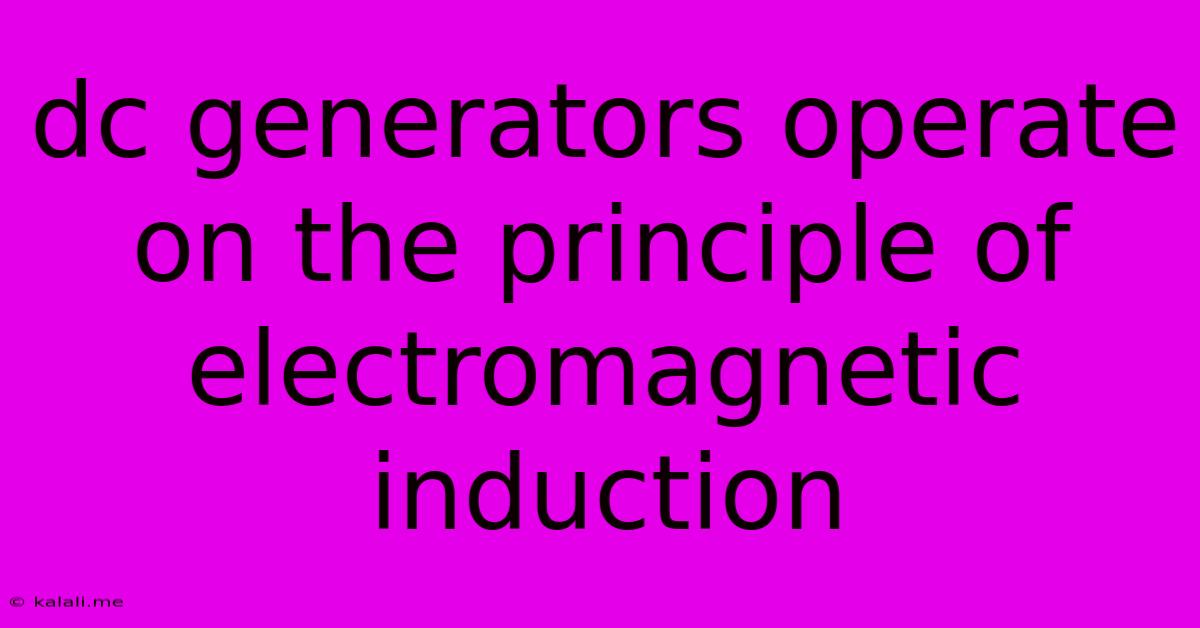Dc Generators Operate On The Principle Of Electromagnetic Induction
Kalali
Jun 15, 2025 · 3 min read

Table of Contents
DC Generators: Operating on the Principle of Electromagnetic Induction
Meta Description: Discover how DC generators work, exploring the fundamental principle of electromagnetic induction, their construction, types, and applications. Learn about armature windings, commutators, and field windings in this comprehensive guide.
DC generators are electromechanical devices that convert mechanical energy into direct current (DC) electrical energy. This conversion relies on a fundamental principle of physics: electromagnetic induction. Understanding this principle is key to grasping how these essential components of many electrical systems operate. This article will delve into the intricacies of DC generators, exploring their operational principles, construction, and various applications.
The Principle of Electromagnetic Induction: The Heart of DC Generators
Electromagnetic induction, as discovered by Michael Faraday, states that a voltage is induced in a conductor when it moves within a magnetic field or when a magnetic field moves relative to a conductor. This induced voltage creates a current flow if a closed circuit is provided. This is the cornerstone of how a DC generator functions.
In a DC generator, a rotating armature (containing coils of wire) moves within a stationary magnetic field. This relative motion between the armature conductors and the magnetic field induces an electromotive force (EMF) or voltage in the armature windings. The magnitude of this induced EMF is directly proportional to the speed of rotation and the strength of the magnetic field.
Construction of a DC Generator
A typical DC generator consists of several key components:
- Armature: The rotating part of the generator, containing coils of insulated wire wound around a soft iron core. This is where the EMF is induced.
- Field Magnets: These create the magnetic field within which the armature rotates. They can be either permanent magnets (in smaller generators) or electromagnets (in larger generators), energized by a separate DC source.
- Commutator: A cylindrical assembly of copper segments, insulated from each other. Its primary function is to convert the alternating current (AC) induced in the armature windings into direct current (DC) output.
- Brushes: Carbon blocks that make contact with the commutator, providing the pathway for the DC current to flow to the external circuit.
Types of DC Generators
DC generators are broadly classified based on their field excitation:
- Separately Excited Generators: The field magnets are energized by a separate DC source, independent of the generator's output. This provides excellent voltage regulation.
- Self-Excited Generators: The field magnets are energized by the generator's own output. This type requires residual magnetism to initiate operation. Sub-types include shunt wound, series wound, and compound wound generators, each exhibiting different voltage-current characteristics.
Understanding Winding Configurations:
The way the armature and field windings are connected significantly impacts the generator's performance. Different winding configurations result in varying voltage regulation and output characteristics, suitable for diverse applications. This includes considerations such as the number of poles and the arrangement of coils within the armature. These factors influence the overall efficiency and power output of the generator.
Applications of DC Generators
DC generators find applications in various fields, including:
- Small-scale power generation: powering small electrical systems in remote areas or for emergency backup power.
- Electroplating: providing a stable DC source for the electroplating process.
- Motor control: Used as excitation sources for DC motors in industrial applications.
- Boosting systems: Used as a DC source for boosting the voltage levels in certain systems.
- Arc welding: supplying the necessary current for arc welding.
Conclusion
DC generators, functioning on the principle of electromagnetic induction, represent a crucial technology in electrical power generation. Their versatility and adaptability to diverse applications underscore their enduring importance, even in an era of increasingly sophisticated power generation technologies. Understanding their construction, operation, and various types is essential for anyone involved in electrical engineering or related fields. Further research into specific applications and design considerations will enhance the understanding of these powerful and enduring machines.
Latest Posts
Latest Posts
-
Lock A Value In Excel Formula
Jun 16, 2025
-
Which Number Is Twice The Sum Of Its Digits
Jun 16, 2025
-
What Are All The Factors Of 13
Jun 16, 2025
-
Which Of The Following Electromagnetic Waves Have The Highest Frequencies
Jun 16, 2025
-
What Is The Multiple Of 15
Jun 16, 2025
Related Post
Thank you for visiting our website which covers about Dc Generators Operate On The Principle Of Electromagnetic Induction . We hope the information provided has been useful to you. Feel free to contact us if you have any questions or need further assistance. See you next time and don't miss to bookmark.